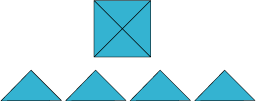Four triangles puzzle
Cut four triangles from a square as shown in the picture. How many different shapes can you make by fitting the four triangles back together?
Problem
If you cut a square diagonally from corner to corner you get four right-angled isosceles triangles.

How many different shapes can you make by fitting the four triangles back together?
You may only fit long sides to long sides and short sides to short sides.
The whole length of the side must be joined.
You might like to record what you do.
You could use this interactivity to try out your ideas.
Click on the grey triangles to make new pieces.
You can rotate them by dragging the corners.
Printable NRICH Roadshow resource.
You may be interested in the other problems in our I Wonder... What If...? Feature.
Getting Started
The best thing to do is to make the triangles and try it out, or use the interactivity!
(You could print this sheet and then cut out the triangles.)
Does it make a difference if you turn one triangle over in any of the arrangements?
How are you making sure all your patterns are different?
Student Solutions
Zac and Olly from Pendragon School Cambridgeshire sent in the following:
I have attached a solution two of my year 6 children came up with to the 'four triangles' problem. They spent three lessons talking about it before coming to their agreed solution!

Orchards Primary in Wisbech (who say they often like to work together in pairs or groups) sent in solutions from their different (tree) classes:
Laburnum Class worked really hard to try to explain how they made their shapes.
The first photograph is Ciara-Rose and Zarah's work. Then Hawthorn Class' solution.


Below is just one picture from Juniper Class' solution

and the rest of their excellent work can be seen here Juniper Y4.docx
The teacher of Year 5 in Bute House Prep School sent in the following:
The Year 5 girls worked in groups to investigate how many arrangements they could find. They considered the different ways they could classify the shapes they made and whether or not they could prove they had them all. The attached document is the conclusions Maya, Kyra and Amelie came to.

You can see more of their work here. What do you make of the key they've created using different symbols to sort particular groups of shapes?
Thank you for these good ideas of working with the triangles. I wonder what happens if you add one more triangle?
Teachers' Resources
Why do this problem?
This low threshold high ceiling task invites learners to be creative with a familiar triangle in a systematic and logical way. It can develop understanding of angles and right angles, and encourages children to visualise.
Possible approach
Key questions
Does it make a difference if you turn one triangle over in this arrangement?
How are you making sure all your patterns are different?
Possible extension
Possible support
Working in pairs would offer support for learners, and the opportunity to talk about their thinking as they work. It might be helpful for some children to be able to stick their arrangements of triangles onto paper as they go along rather than having to record them separately. Photographs could be taken and then shared as a class to discuss duplicates or systematic ways of convincing others that all the possible solutions have been found.
